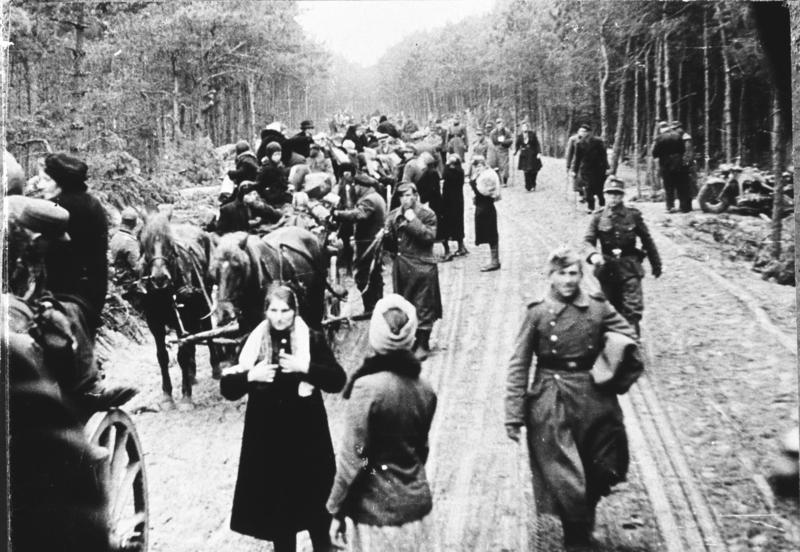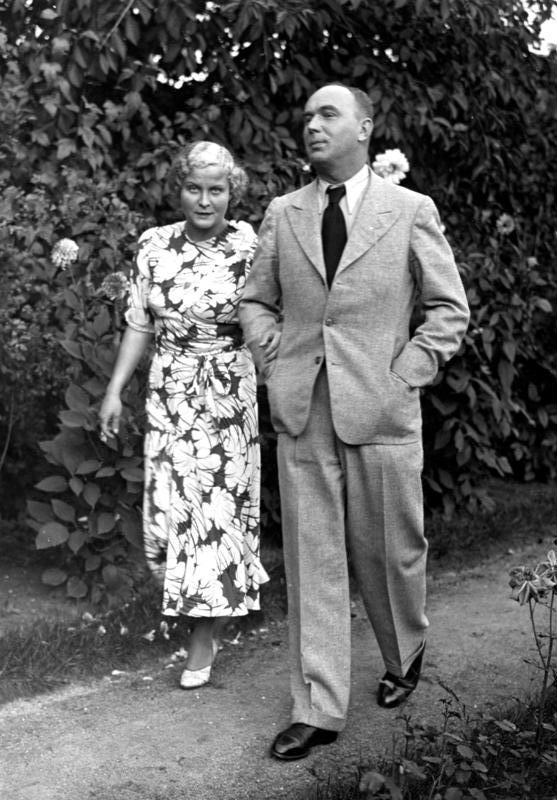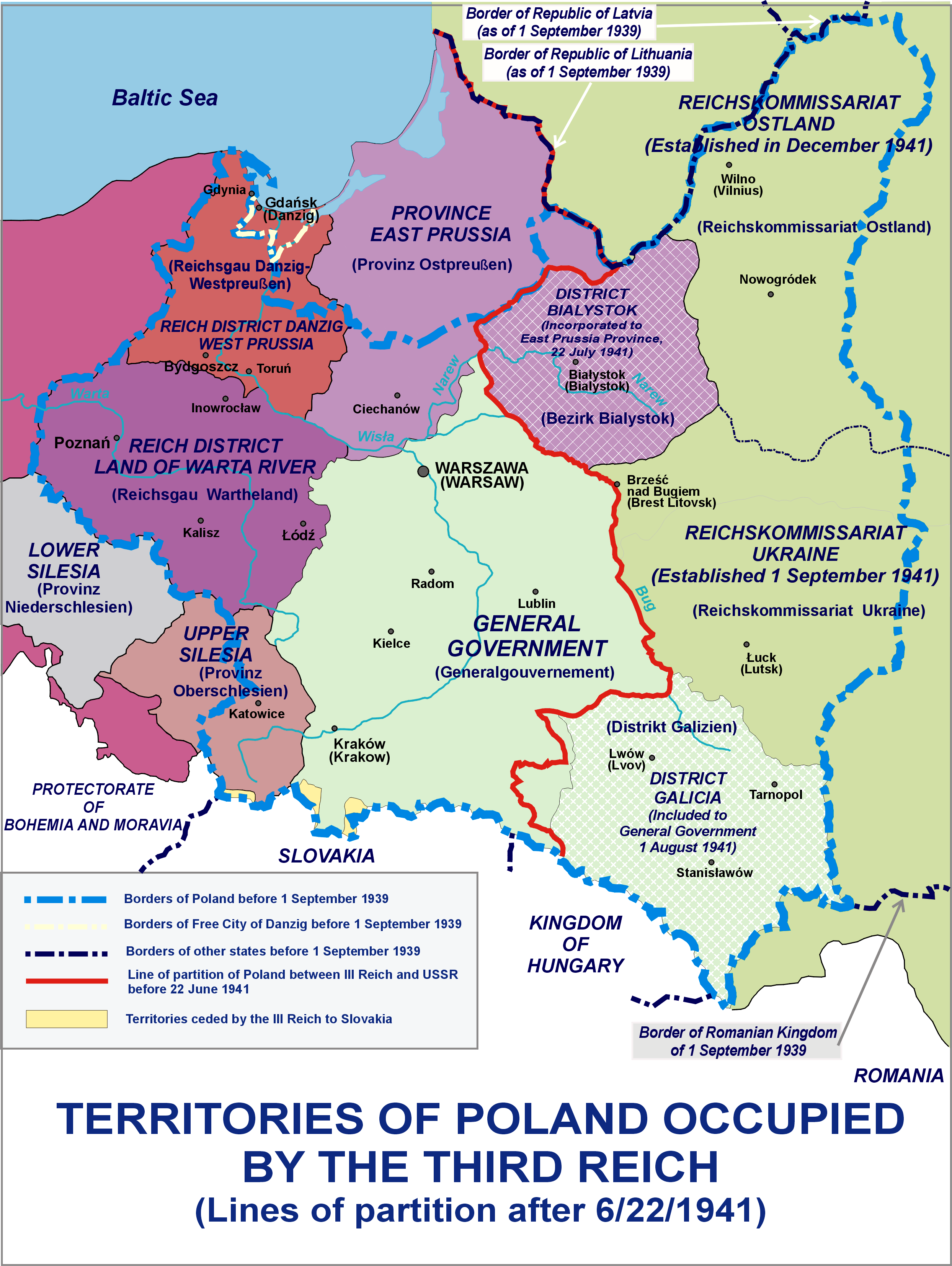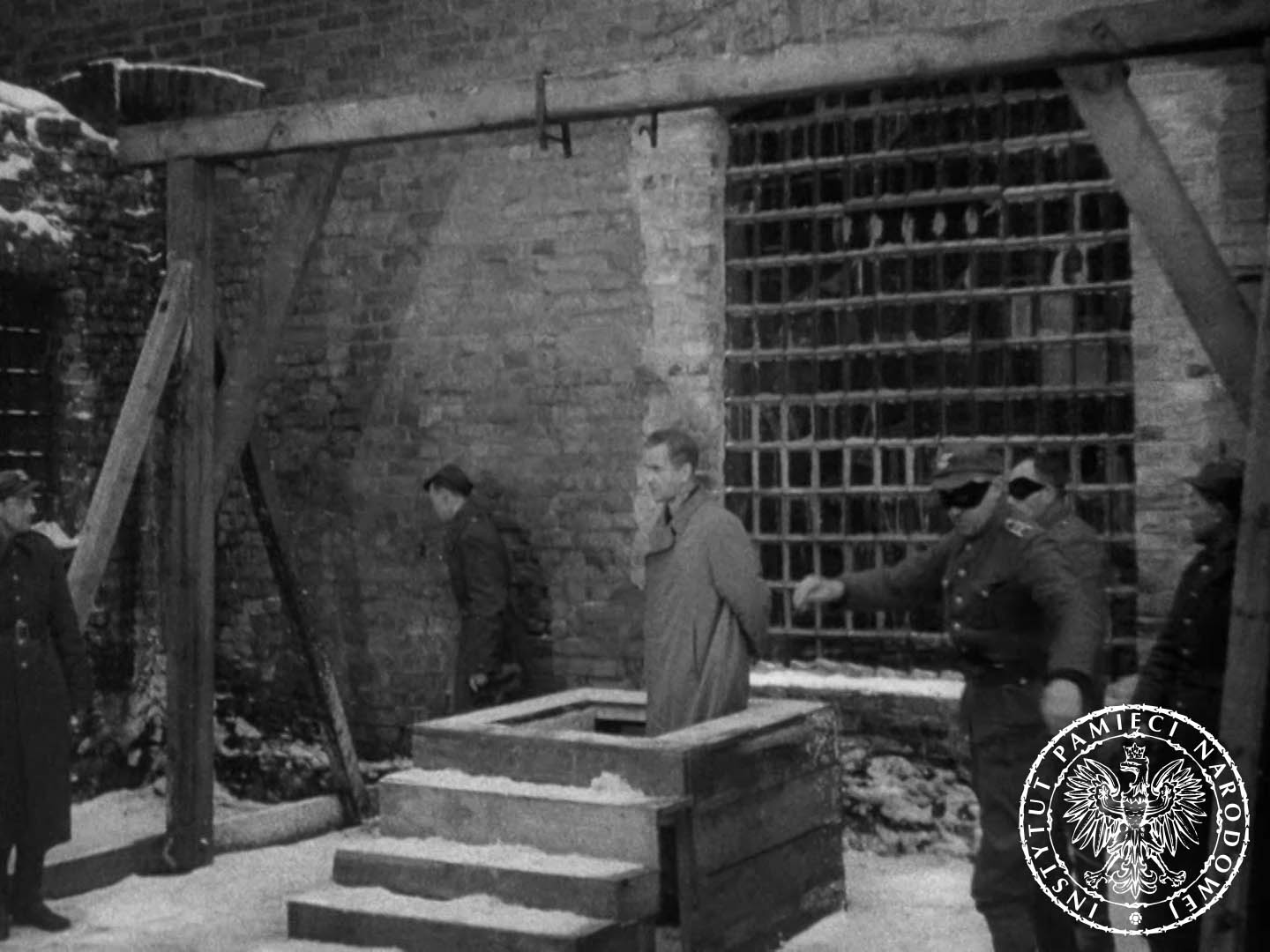|
German Evacuation From Central And Eastern Europe
The German evacuation from Central and Eastern Europe ahead of the Soviet Red Army advance during the Second World War was delayed until the last moment. Plans of to evacuate people to present-day Germany from the territories controlled by Nazi Germany in the Central and Eastern Europe, including from the former eastern territories of Germany as well as occupied territories, were prepared by German authorities only when the defeat was inevitable, which resulted in utter chaos. The evacuation in most of the Nazi-occupied areas began in January 1945, when the Red Army was already rapidly advancing westward. Until March 1945, the Nazi authorities had evacuated from the eastern territories (prewar Germany, Poland, Hungary, Romania and Yugoslavia) an estimated 10 to 15 million persons, Germans as well as citizens of other nations. In the territory of Germany, which Stalin gave to Poland after the war, there were 10 million residents in 1944–1945, including 7.3 million permanent res ... [...More Info...] [...Related Items...] OR: [Wikipedia] [Google] [Baidu] |
Soviet Union
The Soviet Union,. officially the Union of Soviet Socialist Republics. (USSR),. was a transcontinental country that spanned much of Eurasia from 1922 to 1991. A flagship communist state, it was nominally a federal union of fifteen national republics; in practice, both its government and its economy were highly centralized until its final years. It was a one-party state governed by the Communist Party of the Soviet Union, with the city of Moscow serving as its capital as well as that of its largest and most populous republic: the Russian SFSR. Other major cities included Leningrad (Russian SFSR), Kiev (Ukrainian SSR), Minsk ( Byelorussian SSR), Tashkent (Uzbek SSR), Alma-Ata (Kazakh SSR), and Novosibirsk (Russian SFSR). It was the largest country in the world, covering over and spanning eleven time zones. The country's roots lay in the October Revolution of 1917, when the Bolsheviks, under the leadership of Vladimir Lenin, overthrew the Russian Provisional Government ... [...More Info...] [...Related Items...] OR: [Wikipedia] [Google] [Baidu] |
Nazi Concentration Camp
From 1933 to 1945, Nazi Germany operated more than a thousand concentration camps, (officially) or (more commonly). The Nazi concentration camps are distinguished from other types of Nazi camps such as forced-labor camps, as well as concentration camps operated by Germany's allies. on its own territory and in parts of German-occupied Europe. The first camps were established in March 1933 immediately after Adolf Hitler became Chancellor of Germany. Following the Night of Long Knives, 1934 purge of the Sturmabteilung, SA, the concentration camps were run exclusively by the SS via the Concentration Camps Inspectorate and later the SS Main Economic and Administrative Office. Initially, most prisoners were members of the Communist Party of Germany, but as time went on different groups were arrested, including "habitual criminals", "asocials", and Jews. After the beginning of World War II, people from German-occupied Europe were imprisoned in the concentration camps. Following A ... [...More Info...] [...Related Items...] OR: [Wikipedia] [Google] [Baidu] |
Arthur Greiser
Arthur Karl Greiser (22 January 1897 – 21 July 1946) was a Nazi German politician, SS-''Obergruppenführer'', ''Gauleiter'' and ''Reichsstatthalter'' (Reich Governor) of the German-occupied territory of ''Wartheland''. He was one of the persons primarily responsible for organizing the Holocaust in occupied Poland and numerous other crimes against humanity. He was arrested by the Americans in 1945, and was tried, convicted and executed by hanging in Poland in 1946. Early life and career Greiser was born in Schroda (Środa Wielkopolska), Province of Posen, Imperial Germany, Greiser was the son of a minor local bailiff (''Gerichtsvollzieher''). He learned to speak Polish fluently during his childhood. In 1903, he enrolled in elementary school, which was followed by two years of intermediate school and finally the Königlich-Humanistisches Gymnasium (Royal Humanities Secondary School) in Hohensalza, which he left in 1914 without receiving a diploma as in August that year he vol ... [...More Info...] [...Related Items...] OR: [Wikipedia] [Google] [Baidu] |
Greater Poland
Greater Poland, often known by its Polish name Wielkopolska (; german: Großpolen, sv, Storpolen, la, Polonia Maior), is a Polish historical regions, historical region of west-central Poland. Its chief and largest city is Poznań followed by Kalisz, the oldest city in Poland. The boundaries of Greater Poland have varied somewhat throughout history. Since the Middle Ages, Wielkopolska proper has been split into the Poznań Voivodeship (14th century to 1793), Poznań and Kalisz Voivodeship (1314–1793), Kalisz Administrative division of the Polish–Lithuanian Commonwealth, voivodeships. In the wider sense, it also encompassed Sieradz Voivodeship (1339–1793), Sieradz, Łęczyca Voivodeship, Łęczyca, Brześć Kujawski Voivodeship, Brześć Kujawski and Inowrocław Voivodeship, Inowrocław voivodeships, which were situated further eastward. After the Partitions of Poland at the end of the 18th century, Greater Poland was incorporated into Kingdom of Prussia, Prussia as the ... [...More Info...] [...Related Items...] OR: [Wikipedia] [Google] [Baidu] |
Warthegau
The ''Reichsgau Wartheland'' (initially ''Reichsgau Posen'', also: ''Warthegau'') was a Nazi German ''Reichsgau'' formed from parts of Polish territory annexed in 1939 during World War II. It comprised the region of Greater Poland and adjacent areas. Parts of ''Warthegau'' matched the similarly named pre-Versailles Prussian province of Posen. The name was initially derived from the capital city, Posen (Poznań), and later from the main river, Warthe (Warta). During the Partitions of Poland from 1793, the bulk of the area had been annexed by the Kingdom of Prussia until 1807 as South Prussia. From 1815 to 1849, the territory was within the autonomous Grand Duchy of Posen, which was the Province of Posen until Poland was re-established in 1918–1919 following World War I. The area is currently the Greater Poland Voivodeship. Invasion and occupation of Poland After the invasion of Poland, the conquered territory of Greater Poland was split between four ''Reichsgaue'' and th ... [...More Info...] [...Related Items...] OR: [Wikipedia] [Google] [Baidu] |
Ludwig Fischer
Ludwig Fischer (16 April 1905 – 8 March 1947) was a German Nazi Party lawyer, politician and a convicted war crimes, war criminal who was executed for war crimes. Background Born into a Catholic family in Kaiserslautern, Fischer joined the Nazi Party in 1926 while a student, and the ''Sturmabteilung'' (SA) in 1929, eventually rising to the rank of ''SA-Gruppenführer, Gruppenführer''. In 1937, he was elected to the Reichstag (Nazi Germany), Reichstag. Actions during the Nazi occupation of Poland Germany Invasion of Poland, invaded Poland in September 1939. On 24 October 1939 Fischer became Chief Administrator (and in 1941 Governor) of the Warsaw, Warsaw District in the occupied General Government (the area of Poland that Germany did not formally annex). He held this position until the withdrawal of the German forces from Warsaw in January 1945. Fischer was directly responsible for a number of war crimes, as well as crimes against humanity. He oversaw the establishment ... [...More Info...] [...Related Items...] OR: [Wikipedia] [Google] [Baidu] |
Former Eastern Territories Of Germany
The former eastern territories of Germany (german: Ehemalige deutsche Ostgebiete) refer in present-day Germany to those territories east of the current eastern border of Germany i.e. Oder–Neisse line which historically had been considered German and which were annexed by Poland and Soviet Union after World War II, these territories were also the lands where Germans used to be only or main ethnicity. So in contrast to the lands awarded to the restored Polish state by the Treaty of Versailles after World War I, the German territories lost with the Potsdam Agreement after World War II on 1 August 1945 were either almost exclusively inhabited by Germans before 1945 (bulk of East Prussia, bulk of Lower Silesia, Farther Pomerania, and parts of Western Pomerania, Lusatia, and Neumark awarded to Poland), mixed German-Polish with a German majority ( Danzig, Posen-West Prussia Border March, Lauenburg and Bütow Land, the southern and western rim of East Prussia, Ermland, West Upper S ... [...More Info...] [...Related Items...] OR: [Wikipedia] [Google] [Baidu] |
Central Europe
Central Europe is an area of Europe between Western Europe and Eastern Europe, based on a common historical, social and cultural identity. The Thirty Years' War (1618–1648) between Catholicism and Protestantism significantly shaped the area's history. The concept of "Central Europe" appeared in the 19th century. Central Europe comprised most of the territories of the Holy Roman Empire and those of the two neighboring kingdoms of Poland and Hungary. Hungary and parts of Poland were later part of the Habsburg monarchy, which also significantly shaped the history of Central Europe. Unlike their Western European (Portugal, Spain et al.) and Eastern European (Russia) counterparts, the Central European nations never had any notable colonies (either overseas or adjacent) due to their inland location and other factors. It has often been argued that one of the contributing causes of both World War I and World War II was Germany's lack of original overseas colonies. After World War ... [...More Info...] [...Related Items...] OR: [Wikipedia] [Google] [Baidu] |
Eastern Europe
Eastern Europe is a subregion of the Europe, European continent. As a largely ambiguous term, it has a wide range of geopolitical, geographical, ethnic, cultural, and socio-economic connotations. The vast majority of the region is covered by Russia, which spans roughly 40% of the continent's landmass while accounting for approximately 15% of its total population."The Balkans" , ''Global Perspectives: A Remote Sensing and World Issues Site''. Wheeling Jesuit University/Center for Educational Technologies, 1999–2002. It represents a significant part of Culture of Europe, European culture; the main socio-cultural characteristics of Eastern Europe have historically been defined by the traditions of Slavs and Greeks, as well as by the influence of Eastern Christianity as it developed through t ... [...More Info...] [...Related Items...] OR: [Wikipedia] [Google] [Baidu] |
Bundesarchiv Bild 146-1976-072-09, Ostpreußen, Flüchtlingtreck
, type = Archive , seal = , seal_size = , seal_caption = , seal_alt = , logo = Bundesarchiv-Logo.svg , logo_size = , logo_caption = , logo_alt = , image = Bundesarchiv Koblenz.jpg , image_caption = The Federal Archives in Koblenz , image_alt = , formed = , preceding1 = , preceding2 = , dissolved = , superseding1 = , superseding2 = , agency_type = , jurisdiction = , status = Active , headquarters = PotsdamerStraße156075Koblenz , coordinates = , motto = , employees = , budget = million () , chief1_name = Michael Hollmann , chief1_position = President of the Federal Archives , chief2_name = Dr. Andrea Hänger , chief2_position ... [...More Info...] [...Related Items...] OR: [Wikipedia] [Google] [Baidu] |
Ludowe Wojsko Polskie
The Polish People's Army ( pl, Ludowe Wojsko Polskie , LWP) constituted the second formation of the Polish Armed Forces in the East in 1943–1945, and in 1945–1989 the armed forces of the Polish communist state ( from 1952, the Polish People's Republic), ruled by the Polish Workers' Party and then the Polish United Workers' Party. The communist-led Polish armed forces, allowed and facilitated by Joseph Stalin, were the result of efforts made in the early 1940s in the Soviet Union by Wanda Wasilewska and Zygmunt Berling. The official name of those formations were: ''Armia Polska w ZSRR'' (Polish Army in the USSR) from 1943–1944, ''Wojsko Polskie'' (Polish Troops) and ''Siły Zbrojne Rzeczpospolitej Polskiej'' (Armed Forces of the Republic of Poland) from 1944–1952 and from 1952 ''Siły Zbrojne Polskiej Rzeczypospolitej Ludowej'' (Armed Forces of the Polish People's Republic). On 7 October 1950, the anniversary of the Battle of Lenino was declared the official "Day of th ... [...More Info...] [...Related Items...] OR: [Wikipedia] [Google] [Baidu] |






.jpg)